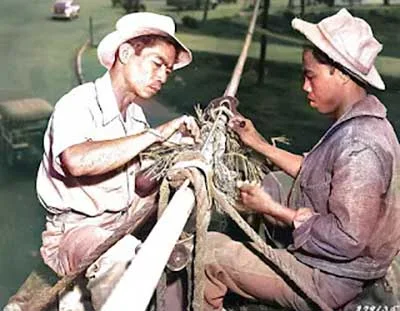The Daring Guerrilla Radio Detachment that Operated in Batangas in WWII
In November 1944, a small detachment was despatched by guerrilla leader Major Bernard L. Anderson to set up an intelligence network and operate a radio station in Batangas. Anderson was a USAFFE officer who avoided capture by the Japanese in 1942, and went on the following year to form and command an underground resistance movement first in Central Luzon and then later in Tayabas1.
This movement would become among the largest of the guerrilla movements operating in the island of Luzon and would have units in many provinces, including Batangas. In mid-1944, what had become known as the “Anderson’s Guerrillas” would establish and maintain contact with the Southwest Pacific Area Command (SWPA) under General Douglas MacArthur. The immediate benefit of this was that the organization would start receiving supplies and radio equipment brought in by American submarines2.
By this same year, the American reconquering forces were already established in Leyte and were preparing for the invasion of Luzon early in 1945. Crucial to this invasion was accurate intelligence information on the enemy. Because a landing on the beaches of Nasugbu was part of the invasion plans, it goes without saying that that accurate intelligence on the Japanese Imperial Army’s positions and movements in Batangas were of the utmost importance.
The small unit sent by Anderson to set up an intelligence network and operate a radio station in Batangas was commanded by one Captain Alfonso Panopio, a veteran guerrilla erstwhile operating in Samar under American officer Maj. Charles Smith. He was sent to Luzon to cooperate with Anderson’s guerrillas.
Initially, Panopio set up a special detachment to gather intelligence and operate a radio station with the call sign C U P at barrio Laiya in the municipality of San Juan. With him in this detachment were M/Sgt. Maximiano Garcia, Sgt. Pascual Solis, brothers 1/Sgt. Arsenio and S/Sgt. Alfredo Aguilera and Cpl. Servillano Adajio3. The seventh member of the detachment, regrettably, was not named in the source document.
Intelligence reports collected from the “Batangas Sector” by operatives were sent to one Lt. Felino Paran, designated as the Chief Intelligence Operative. He compiled and evaluated the reports and then forwarded the information to the headquarters of the Chief Agent, one Atty. Hermenegildo Lopez, whose headquarters was located at barrio Pagolingin in Lipa. The filtered reports were then sent to the radio station for relay to the headquarters of the Anderson’s Guerrillas and, crucially, to the SWPA4.
Later, the radio station would relocate to Mataasnakahoy, right where the Japanese had what a US Army officer called the Japanese Army’s “center of operations5.” This was because the municipality was right beside the Lipa Airfield of the Japanese Imperial Army.
Needless to say, the men operating the radio station as well as the operatives gathering intelligence were vigorously hunted down by the Japanese. The following radio message sent to Anderson’s Guerrillas headquarters provides an insight on the peril these men had to live with:
“CANT OPERATE FOR DAYS PD JAPS CAME AND MADE GROUNDS SURVEY PD BELIEVED TO BE LOOKING FOR SEA OBSERVATION POST PD ANY NEW DEVELOPMENT THEY DO WILL BE POSTED PROMPTLY PD HAVE BEEN ON THE RUN FOR DAYS PD6” [PD = Full Stop, Period (.)]
Of the seven men of the radio station detachment, three would not live to see the province liberated. 1/Sgt. Arsenio Aguilera was a Fine Arts student who worked for the Japanese military police, the Kempei Tai, in Lipa, while leaking secrets to the guerrillas, including Japanese positions on Mt. Maculot and barrio Sulok, Sto. Tomas. He would be found out and executed in February 1945.
Arsenio’s brother Alfredo, meanwhile, worked as houseboy and cook for the Japanese at the Lipa Airfield before being assigned to the detachment. He used his knowledge of the Japanese installations to feed information to headquarters and to do sabotage work. He even stole bullets from the Japanese and brought these to Lopez’s headquarters in barrio Pagolingin. He was captured and killed the same month as his brother.
The final member of the detachment who would not survive the war was Adajio, assigned operative for the town of Cuenca. In December 1944, having collected information from Mataasnakahoy, he stayed the night at the headquarters of guerrilla Victor Dimaculangan, known as “Major Rey.” Unfortunately, the place was raided by the Japanese that very same night and Adajio was among those killed in the ensuing firefight.
In December 1947, this small unit that operated out of San Juan, Lipa and Mataasnakahoy and fed valuable information to the United States Army was finally given official recognition as having been “an element of the Philippine Army in the service of the United States Armed Forces” during the liberation of the country.
2 “Reports of General MacArthur, the Campaigns of MacArthur in the Pacific — Chapter X: Guerrilla Activities in the Philippines,” by the General Douglas MacArthur’s General Staff, online at the US Army.
3 “A Brief History of the Members of Radio Station C U P,” by Alfonso Panopio, “Special Detachment Radio Station CUP, Anderson’s Grlas,” File No. 101-13, online at the United States National Archives.
4 “A Brief History of the Radio Station C U P,” by Alfonso Panopio, “Special Detachment Radio Station CUP, Anderson’s Grlas,” File No. 101-13, online at the United States National Archives.
5 “Reconsideration Report on the Radio Station C U P,” by Capt. Robert L. Morton, “Special Detachment Radio Station CUP, Anderson’s Grlas,” File No. 101-13, online at the United States National Archives.
6 “Radio Messages from Station C.U.P.,” “Special Detachment Radio Station CUP, Anderson’s Grlas,” File No. 101-13, online at the United States National Archives.

